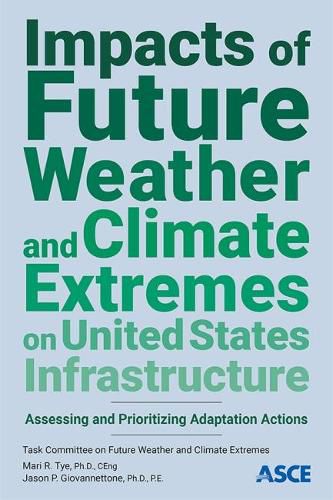Impacts of Future Weather and Climate Extremes on United States Infrastructure: Assessing and Prioritizing Adaptation Actions
Mari R Tye,Jason P. Giovannettone

Impacts of Future Weather and Climate Extremes on United States Infrastructure: Assessing and Prioritizing Adaptation Actions
Mari R Tye,Jason P. Giovannettone
Impacts of Future Weather and Climate Extremes on United States Infrastructure: Assessing and Prioritizing Adaptation Actions summarizes the likely changes in various extreme meteorological and hydrological events and assesses the vulnerabilities of infrastructure within critical sectors and their collective interdependencies. All policy makers and engineers involved in infrastructure planning and design, from the federal level to local stakeholders, will find the summaries of impacts and the suggested prioritization framework as helpful guides in accommodating projected future weather and climate extremes for their locale.
|Impacts of Future Weather and Climate Extremes on United States Infrastructure: Assessing and Prioritizing Adaptation Actions summarizes the likely changes in various extreme meteorological and hydrological events and assesses the vulnerabilities of infrastructure within critical sectors and their collective interdependencies. All policy makers and engineers involved in infrastructure planning and design, from the federal level to local stakeholders, will find the summaries of impacts and the suggested prioritization framework as helpful guides in accommodating projected future weather and climate extremes for their locale.|Prepared by the Task Committee on Future Weather and Climate Extremes of the Committee on Adaptation to a Changing Climate of ASCE
Impacts of Future Weather and Climate Extremes on United States Infrastructure: Assessing and Prioritizing Adaptation Actions summarizes the likely changes in various extreme meteorological and hydrological events and assesses the vulnerabilities of infrastructure within critical sectors and their collective interdependencies. In addition, frameworks that decision makers can use to prioritize limited budgetary resources for adaptation efforts are reviewed.
Critical sectors are aggregated into five overarching infrastructure sectors: energy; transportation, including roads, bridges, rail, transit, and aviation; drinking water and wastewater; water storage and flood protection; and navigation, including ports and harbors. Each sector is reviewed with respect to the potential impacts of climate change pertinent to that sector, current sector fragility or resilience to such impacts, adaptation readiness, and dependency on or contribution to other sectors.
The book continues with a proposed step-by-step prioritization process, which includes several questions that may be considered depending on the context, and examples of case-specific prioritization frameworks used by other organizations. A proposal for necessary future research concludes the publication.
All policy makers and engineers involved in infrastructure planning and design, from the federal level to local stakeholders, will find the summaries of impacts and the suggested prioritization framework as helpful guides in accommodating projected future weather and climate extremes for their locale.
This item is not currently in-stock. It can be ordered online and is expected to ship in approx 4 weeks
Our stock data is updated periodically, and availability may change throughout the day for in-demand items. Please call the relevant shop for the most current stock information. Prices are subject to change without notice.
Sign in or become a Readings Member to add this title to a wishlist.

